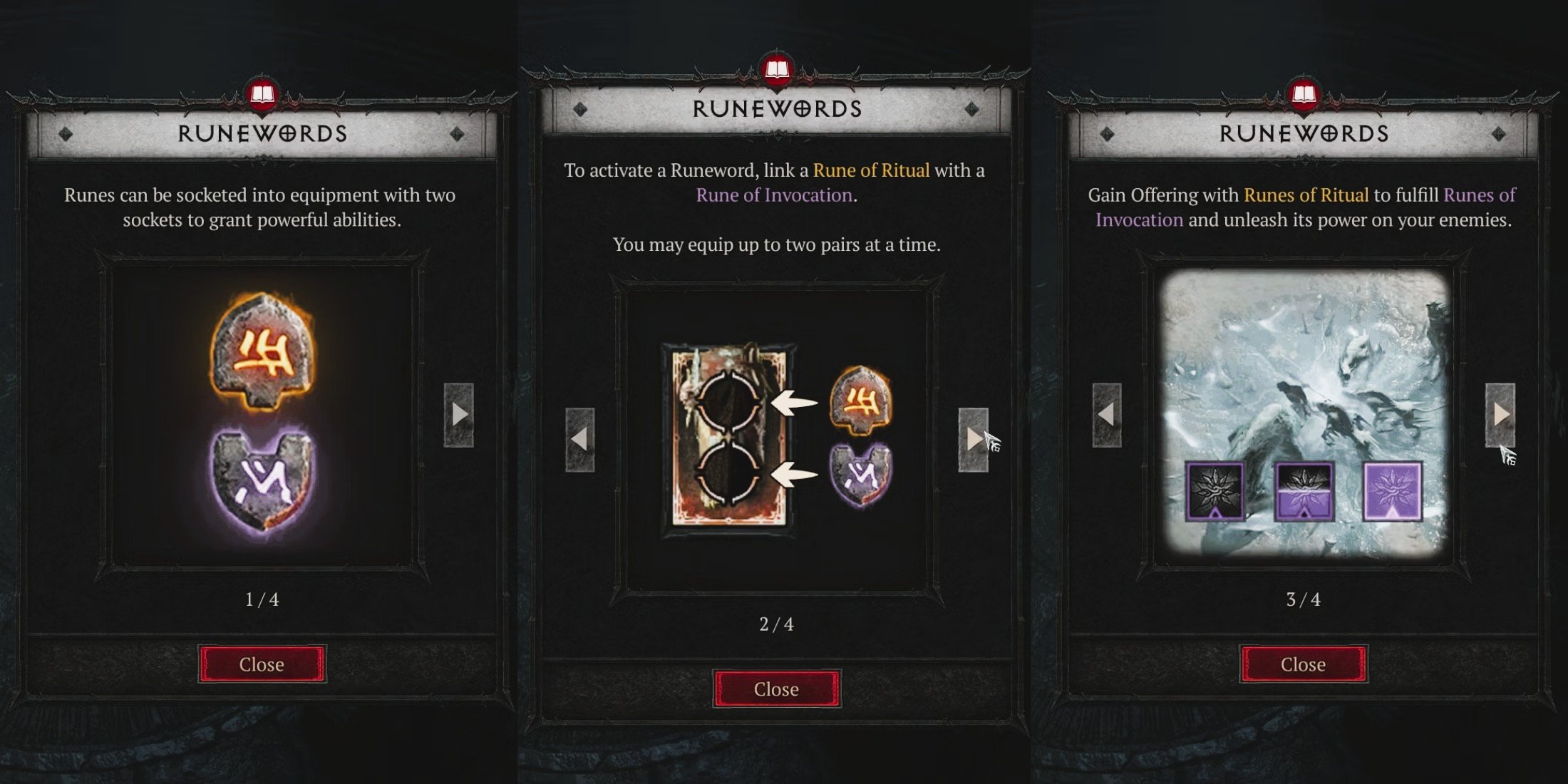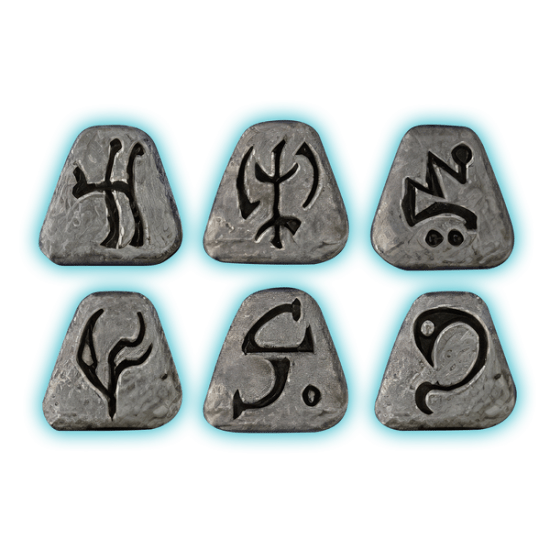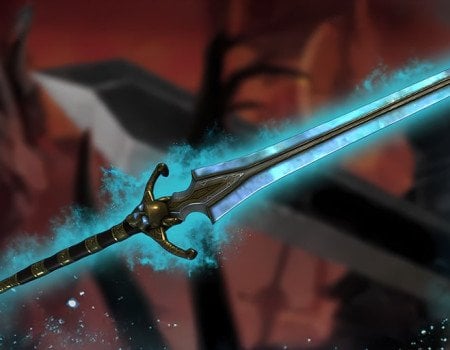Welcome to the Diablo 4 Runewords guide, saviors of Sanctuary. Today, I thought we should talk about a pretty cool mechanic that revolves around runes, which can be combined into runewords that provide various benefits for your class and build. The only thing that you need to have to be able to find and use runes is the Vessel of Hatred expansion. If you do, let’s get going.
By the way, if you don’t want to waste your time farming or crafting the runes that you need, you can simply buy the Runewords boost at Skycoach, which will get you any amount of any runewords you desire. This is a faster and better way to get your runewords without the hustle. Skycoach’s professional D4 players will very quickly deliver the requested items (runewords) to your account as soon as you place the order. Click the link for more info.
Read our other Diablo 4 guides:
Note: At Skycoach, you can Buy Diablo 4 Boost at the best prices with fast delivery. Use our special PROMO CODE (in green) hidden in this article for a 20% DISCOUNT.
What Are Runewords & How They Work
In Diablo 4: Vessel of Hatred, Runewords are a powerful late-game system that lets you slot custom effects into your gear — like passive skills you craft yourself. If you’re coming from Diablo 2, forget the old formulas. This isn’t about memorizing sequences. In D4, Runewords are about building synergy between action and reward.
You don’t need a recipe. You just need two runes and a two-socket item.
Ritual and Invocation Runes
Every Runeword is built from two runes:
- Ritual Rune – Watches your gameplay. It tracks when you do something specific, like casting a Core skill or dodging an attack.
- Invocation Rune – Delivers the effect. Once your Ritual Rune generates enough Offering, this rune triggers the payoff.
When you combine them in a two-socket item, they become one Runeword. The Ritual Rune fills an internal Offering bar as you play, and when the required Offering amount is reached, the Invocation Rune activates.
Here’s what that structure looks like:
| Component | Role | Example |
| Ritual Rune | Gains Offering when a specific condition is met | Cast a Core skill = +25 Offering |
| Invocation Rune | Uses Offering to trigger an effect | Gain +1 to all skills for 10 sec (Cost: 100 Offering) |
You can mix and match any Ritual with any Invocation. Once they're slotted in gear, they start tracking automatically in combat — no extra input required.
Runes come in three rarities:
- Magic (Blue)
- Rare (Yellow)
- Legendary (Orange)
Higher rarity runes typically offer more powerful effects or better synergy with Overflow. If you’re aiming for top-tier Runewords, Legendary Runes are often required. They also play a key role in Mythic Unique crafting.

Understanding Offering & Overflow
Offering is the fuel that powers Runewords. Every time your Ritual Rune condition is met, it adds a set amount of Offering. Once you reach the required amount, your Invocation Rune activates.
But there’s an advanced layer called Overflow — and it matters a lot.
If you generate more Offering than the Invocation Rune needs, you get a bonus effect. These Overflow bonuses vary by rune — some extend duration, others boost damage, spawn extra projectiles, or apply additional effects.
Example: If your Invocation requires 100 Offering, but your Ritual generates 150 in one hit, you’ll get the base effect plus Overflow scaling — often doubling the impact.
For optimal builds, pairing a Ritual Rune that overfills the Offering threshold is key to maximizing rune value. BLOG20
How to Use Runewords in Diablo 4
Enough theory, here’s what you need and how to use Runewords Diablo 4:
- Exactly two sockets — no more, no less
- Must be a Helm, Chest, Pants, or Two-Handed Weapon
- Gems and Runewords can’t coexist — runes replace socketables
Inserting runes is easy: drag a Ritual Rune and an Invocation Rune into the sockets. Order doesn’t matter, but rune selection does.
And one critical limitation: Runes are Unique Equipped. You can’t use the same rune in multiple Runewords, even in different roles. So if you're running two Runewords, you’re limited to four unique runes total — no duplicates.
How Runewords Activate During Combat
Once equipped, your Runewords start working immediately. In combat, you’ll see icons on your buff bar that track Offering progress.
Here’s how a typical trigger plays out:
Example: Tam + Ohm
- Tam (Ritual) generates 25 Offering whenever you cast a Core Skill
- Ohm (Invocation) needs 500 Offering to trigger War Cry
- After 20 Core Skill casts, Ohm fires off — increasing your damage and movement speed
- If your Offering goes beyond 500, the Overflow bonus kicks in, further boosting the buff duration
Offering pools are tracked separately per Runeword, so progress for one doesn’t affect the other.
Where Are Runes in Your Inventory
Managing runes is easy — but it’s just as easy to lose track of them if you're careless. Here’s how it works:
- Runes stack in your inventory or stash and appear under the “Socketables” tab
- You can unsocket runes for free at the Jeweler
- Salvaging an item returns the runes to your inventory
- But if you sell a socketed item to a vendor and it drops off the Buyback screen, those runes are gone forever
Pro tip: Always unsocket runes before salvaging or selling — especially if they’re Legendary. There’s no recovery if you mess up.
Also worth noting: Runes are tradable, so if you get a Legendary you don’t need, you can flip it for something your build actually uses.
Best Runeword Combinations (Season 8 Meta)
Runewords in Diablo 4: Vessel of Hatred aren't just passive buffs — they’re mini-builds in your gear. Each combo listed below has been field-tested in meta builds this season, with strong synergy between the trigger (Ritual) and the effect (Invocation). Some combos lean offensive, others are defensive, and a few are great utility tools that scale with gear or group play.
What ties them all together is this: they’re reliable, efficient, and build-friendly. Below is a Diablo 4 best runewords list filled with combinations currently worth your sockets.
| Runeword | What It Does | Works Best On |
| Igni + Xan | Guarantees Crit + Overpower on next attack. Overflows boost duration. | Barbarian, Druid, Necromancer (can fit Spiritborn with Overpower scaling) |
| Igni + Qax | Spends all Primary Resource for up to 100% bonus damage. Overflow boosts further. | Sorcerer, Rogue, Druid (Spiritborn with burst setups) |
| Tam + Ohm | Triggers War Cry on Core Skill use for damage and movement speed. Overflow adds duration. | Barbarian, Rogue, Sorcerer, Spiritborn (Core-heavy builds) |
| Tam + Mot | Grants Dark Shroud stacks for passive DR on Core Skill use. | Rogue, Necro, Druid (defensive Spiritborn also benefit) |
| Nagu + Ohm | Triggers War Cry when a Summon is active. Boosts damage and team movement. | Necromancer, Druid, Sorcerer (less reliable for Spiritborn unless minions are available) |
| Nagu + Ceh | Summons a Spirit Wolf as an extra attacker. Scales with summons. | Pet builds (Necromancer, Druid) |
| Feo + Ner | Triggers Concealment when CC'd or Injured: Stealth, Unstoppable, Dodge. | PvP, Hardcore builds (universal panic button) |
| Cir + Lac | Activates Challenging Shout after 3x cast of same skill. DR + Taunt. | Barbarian, Druid, Spiritborn (melee and tank variants) |
| Cir + Gar | Stacks Crit Chance (up to +25%) with repeated skill use. | Rogue, Barbarian, fast-casting Sorcerer (Spiritborn also viable with speed builds) |
Even though some of these may sound niche, the Ritual triggers are mostly easy to hit in real combat. That’s why Igni and Tam show up so often — they’re reliable and slot naturally into most builds without needing to alter your rotation.
For example, if you’re running a Sorcerer that casts nonstop Core abilities, Tam + Ohm will trigger regularly and boost both solo and group performance. On the other hand, if you’re leaning into Critical or Overpower-focused damage, Igni + Xan and Cir + Gar are hard to beat — especially once you start stacking multipliers.
Tip: Keep in mind that Offering generation happens per Runeword. Even if two combos use the same Ritual type (like Tam), they won’t share progress bars. Each one fills separately and independently tracks its activation cooldown.
Some of these combos also scale well with Overflow, so you’ll want to make sure your Ritual Rune isn’t just meeting the Offering requirement, but exceeding it when possible. For example, pairing Igni’s 500 stored Offering with Qax (which only needs 400) guarantees you’re getting the maximum Overflow damage bonus every time.
How to Farm Runes in D4

If you want more Runewords, you need more Runes — and not just any runes. You’ll need a good mix of Ritual and Invocation runes, and ideally some Legendary ones to unlock stronger combos. So, here’s how to farm Runes in D4 through all of the available sources.
Before farming, there’s one thing you absolutely have to do.
Unlock Runes First
Runes won’t drop at all until you finish a key campaign chapter.
You must complete the “Fundament of Faith” chapter in the Vessel of Hatred campaign. That unlocks the rune system globally — you won’t see drops or crafting options until this is done.
Once that’s cleared, here’s where to go.
Where to Get Runes
Not all activities are equal when it comes to rune farming. Here are the best sources that consistently give you what you need — whether that’s bulk runes, high rarities, or specific crafting materials.
You’ll find the best results in these:
| Source | Why It Matters |
| Campaign Bosses (One-Time Only) | First kill of each VoH boss guarantees Runes. You only get these once — no repeat farming. |
| Kurast Undercity (Tribute of Mystique / Harmony) | Guaranteed Rune drop if you complete the run with Attunement Rank 1+. The most repeatable farm. |
| World Bosses | Can drop Rare and Legendary Runes. Great if you’re targeting higher-tier gear or stacking other loot. |
| Helltide Chests & Whisper Caches | Regular activity farming with a good chance at Magic and Rare Runes. Doesn’t require special setup. |
| Lair Bosses (Grigoire, Zir, Varshan, Beast in Ice) | Best drop chance for Legendary Runes. These are your top priority if you’re chasing meta Runewords. |
| Augment Caches (Bartering Vendor in The Den) | Available after reaching Rapport VIII with Aldkin. Caches can contain Gems, Prisms, and Runes. RNG-heavy but worth checking. |
These all stack well with seasonal grinds, so you’re not going out of your way. For efficient farming, rotate between Kurast, World Bosses, and Lairs.
Crafting at the Jeweler
Even if you get nothing but duplicates, you can still make progress.
Runeword crafting Diablo 4 is done at the Jeweler, where you can combine three identical Runes to create a new random one. This works with Magic, Rare, or Legendary runes and costs 4,000 gold per craft. It’s not targeted, but it's a good way to convert surplus into something usable.
Here’s a quick summary:
- Combine three of the same rune to create one random rune
- Each combine costs 4,000 gold
- The result is always different from the input — and has a chance to be a higher rarity
You can also select between different crafting options, such as:
- Random Magic/Rare Rune
- Random Rare/Legendary Rune
- Random Legendary Rune (requires Rare runes)
This system is especially useful for breaking down stockpiled lower-tier runes and trying your luck for Invocation types you're missing.
Trading & Unsocketing Tips
Managing your rune inventory matters. Unlike gems, Runes are fully recoverable — but only if you’re careful.
- You can unsocket Runes for free at the Jeweler. BLOG20
- If you salvage gear, Runes go back into your inventory.
- If you sell gear with Runes still inside and it drops off the Buyback list? That’s it — the Runes are gone.
Also worth noting: Runes can be traded, so if you get a Legendary you don’t need, consider flipping it.
Before you salvage or sell anything with sockets, check your gear. Mistakes here cost you real value.
Conclusion
Runewords in Diablo 4 are a smart way to boost your build with effects that match how you play. All you need is the Vessel of Hatred expansion, some two-socket gear, and the right pair of runes.
Once you unlock them, Runewords are easy to set up, powerful in combat, and flexible enough to fit any class — from Core skill spam to pet builds or big Overpower crits.
And if farming or crafting sounds like a grind? You can skip the hassle with a Runewords Boost from Skycoach, where pros deliver exactly what you need, fast.
Now go make your gear work harder.
F.A.Q.
What are Runewords in Diablo 4?
Runewords are socketed item upgrades made by combining a Ritual Rune and an Invocation Rune. They trigger effects based on your gameplay actions, like casting skills or taking damage.
How to get Runes in D4?
- Complete the “Fundament of Faith” quest to unlock Rune drops
- Farm Kurast Undercity, World Bosses, Helltides, Lair Bosses
- Craft them at the Jeweler or buy from other players
What are the best runewords for my class in D4?
It depends on your build, but popular combos include:
- Tam + Ohm for Core-skill builds
- Igni + Xan for Crit/Overpower
- Nagu + Ohm for summon-based builds
Can I craft Runes in Diablo 4?
Yes. Combine 3 identical runes at the Jeweler to get a random new one. This can also upgrade the rune’s rarity.
How to use Runes in Diablo 4?
Insert one Ritual and one Invocation rune into a 2-socket Helm, Chest, Pants, or 2H Weapon. Once equipped, the Runeword activates automatically in combat.

















